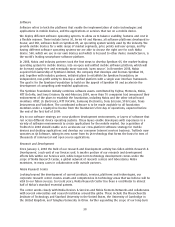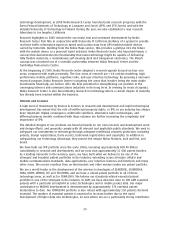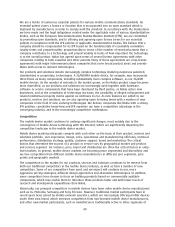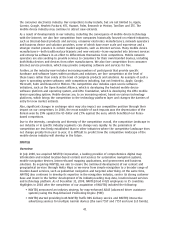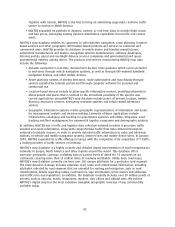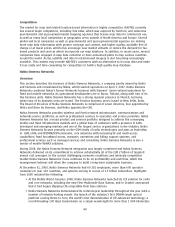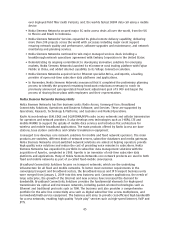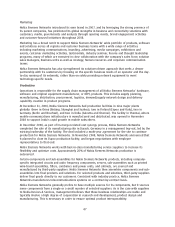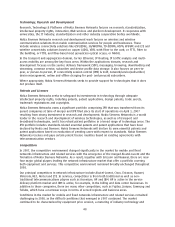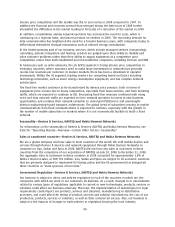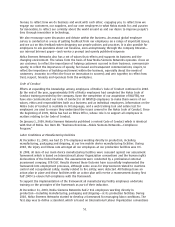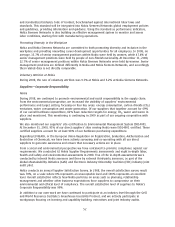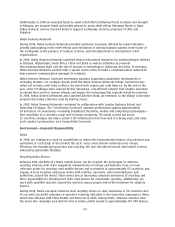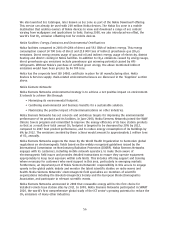Nokia 2008 Annual Report Download - page 49
Download and view the complete annual report
Please find page 49 of the 2008 Nokia annual report below. You can navigate through the pages in the report by either clicking on the pages listed below, or by using the keyword search tool below to find specific information within the annual report.Technology, Research and Development
Research, Technology & Platforms of Nokia Siemens Networks focuses on research, standardization,
intellectual property rights, innovation, R&D services and platform development. It cooperates with
universities, the IT industry, standardization and other industry cooperation bodies worldwide.
Nokia Siemens Networks research and development work focuses on wireless and wireline
communication solutions that enable communication services for people and businesses. These
include wireless connectivity solutions like GSM/EDGE, 3G/WCDMA, TDSCDMA, HSPA, WiMAX and LTE and
wireline connectivity solutions based on copper (ADSL, VDSL with Fiber to the curb, or FTTC, Fiber to
the building, or FTTB, and fiberbased next generation optical access, or NGOA).
In the transport and aggregation domain, Carrier Ethernet, IP Routing, IP traffic analysis and multi
access mobility are among the key focus areas. Within the applications domain, research and
development focuses on the service delivery framework (SDF), messaging, browsing, downloading and
streaming, common service, subscriber and device profile data storage. It also focuses on peerto
peer, or persontoperson, IP connectivity session control (IMS) & VoIP, network/service/subscriber/
device management, online and offline charging for post and prepaid subscribers.
Where appropriate, Nokia Siemens Networks seeks to provide support for technologies that it does
not produce itself.
Patents and Licenses
Nokia Siemens Networks seeks to safeguard its investments in technology through adequate
intellectual property rights, including patents, patent applications, design patents, trade secrets,
trademark registrations and copyrights.
Nokia Siemens Networks owns a significant portfolio comprising IPR that was transferred from its
parent companies at time of merger and IPR filed since its start of operations on April 1, 2007
resulting from strong investment in research and development. Nokia Siemens Networks is a world
leader in the research and development of wireless technologies, as well as of transport and
broadband technologies, and it has robust patent portfolios in a broad range of technology areas. The
IPR portfolio includes standardsrelated essential patents and patent applications that have been
declared by Nokia and Siemens. Nokia Siemens Networks will declare its own essential patents and
patent applications based on evaluation of pending cases with respect to standards. Nokia Siemens
Networks receives and pays certain patent license royalties based on existing agreements with
telecommunication vendors.
Competition
In 2007, the competitive environment changed significantly in the market for mobile and fixed
networks infrastructure and related services with the emergence of the merged AlcatelLucent and the
formation of Nokia Siemens Networks. As a result, together with Ericsson and Huawei, there are now
four major global players leading the network infrastructure market that offer a portfolio covering
both equipment and services. This competitive environment remained broadly unchanged throughout
2008.
Our principal competitors in network infrastructure include AlcatelLucent, Cisco, Ericsson, Huawei,
Motorola, NEC, Nortel and ZTE. In services, competition is from both traditional as well as non
traditional telecommunications players such as Accenture, HP and IBM. HP is active in the service
delivery platform market and IBM is active, for example, in the billing and data center businesses. In
addition to these companies, there are many other competitors, such as Fujitsu, Juniper, Samsung and
Tellabs, which have a narrower scope in terms of served regions and business areas.
Conditions in the market for mobile and fixed networks infrastructure and related services remained
challenging in 2008, as the difficult conditions that emerged in 2007 continued. The market
continued to be characterized by equipment price erosion, a maturing of industry technology and
48


